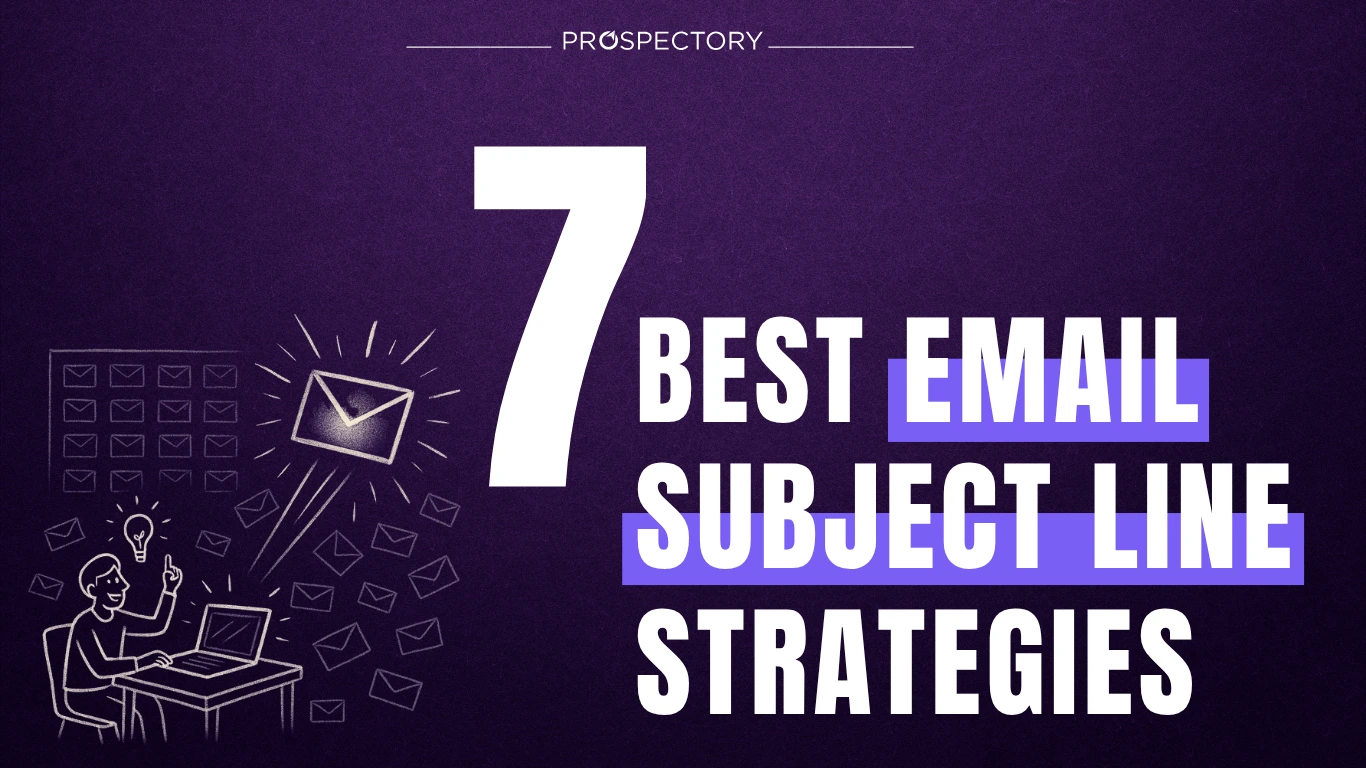7 Best Email Subject Line Strategies (and the Psychology Behind Them)

Have you felt the frustration of trying to find the “perfect” subject line?
Your “perfect” AI has written the best email subject line, crafted a solid value prop, and even personalized the hook - and then nothing. No reply. And an open rate that’s embarrassing.
It wasn’t the pitch that failed. It was the blah, blah, blah, email subject line.
At Prospectory, we know that in B2B sales, the email subject line isn’t decoration. It’s like a secret password that opens up someone’s mind enough to make them your potential customer.
The psychology behind subject lines runs deep - primacy effect, curiosity gaps, urgency triggers, cognitive fluency.
Get it right, and you earn the open. Get it wrong, and you’re standing outside the “read my email” club for all eternity.
7 Best Email Strategies and The Psychology Behind Them
1. The Short Line
The psychology: Our brains crave easy activities. Short, scannable words are processed faster and remembered better. This makes a difference in an inbox where attention spans are measured in seconds.
How to do it: Keep email subject lines under 50 characters. Say something specific in as few words as possible.
- Weak: “Update” (So vague it could mean anything.)
- Winning: “Q4 Insights for Your Team” (Short, direct, relevant.)
- Overdone: “Comprehensive Q4 Product Feature Portfolio Update” (Too long, feels like work.)
2. The Curiosity Line
The psychology: Humans are wired to close “open loops.” When you hint at something in a subject line, but don’t reveal all of it, the brain wants to know the rest - the Zeigarnik effect. The only way to relieve it? Click and find out.
How to do it: Ask a question or suggest a benefit, but leave just enough unsaid.
- Weak: “Checking in” (Dead air. No curiosity triggered.)
- Winning: “Have You Tried This Yet?” (Open-ended, promising but not pushy.)
- Overdone: “Something’s Happening and You’ll Want to Know” (So vague it frustrates instead of intrigues.)
3. The Personalized Line
The psychology: The cocktail party effect. When someone says your name in a noisy room, you notice right away. Email subject lines with names and details light up the same attention pathways.
How to do it: Use a name plus one real, contextual detail - enough to feel intentional, not creepy.
- Weak: “Solutions for your company” (Generic. Could apply to anyone.)
- Winning: “Mark, Scaling Outreach for a 20-Person Sales Team” (Name + detail proves research.)
- Overdone: “Mark, I saw you posted on LinkedIn at 10:32pm last Tuesday” (Crosses the line into surveillance.)
4. The Numbers Line
The psychology: Numbers create the illusion of certainty. Anchoring bias makes us trust quantified statements more than vague claims. Use numbers in emails subject lines but make them realistic.
How to do it: Keep numbers small, believable, and specific.
- Weak: “Improve ROI” (Abstract, no anchor.)
- Winning: “3 Ways to Cut SaaS Costs in Q1” (Specific, tangible.)
- Overdone: “Guarantee 300% ROI in 7 Days” (Unrealistic. Triggers skepticism instead of trust.)
5. The Urgency Line
The psychology: Scarcity bias. When we believe time or opportunity is limited, our brain gives it a higher value and makes it more urgent. But urgency only works if it feels real.
How to do it: Tie urgency to actual deadlines - an event date, quarter-end, limited spots.
- Weak: “Our webinar is coming soon” (Soon = ignorable.)
- Winning: “24 Hours Left to Join Tomorrow’s Demo” (Specific, actionable, real.)
- Overdone: “Last Chance - Act Now or Miss Out Forever” (Feels contrived, erodes credibility.)
6. The Emotional Line
The psychology: People don’t buy with spreadsheets alone. Emotional resonance drives decisions, even in B2B. Pride, frustration, relief - these are motivators.
How to do it: Frame the subject line around a feeling your prospect actually has, not exaggerated drama.
- Weak: “Learn More About Our Platform” (Flat, emotionless.)
- Winning: “Your Team Deserves Simpler Workflows” (Empathetic, aspirational.)
- Overdone: “Your Entire Strategy Depends on This One Email” (Fear-based, manipulative.)
7. The Power Word Line
The psychology: Certain words act as attention magnets. “Exclusive,” “proven,” “new” trigger novelty bias and FOMO. But overload dulls the effect.
How to do it: Use one strong power word in context.
- Weak: “Updates for you” (Neutral. No pull.)
- Winning: “Exclusive Invite: AI Strategy Session for CFOs” (Targeted, authoritative.)
- Overdone: “Exclusive Ultimate Proven Breakthrough Every CEO Must See” (Jargon soup. No credibility.)
The Bigger Picture: Email Subject Lines = Secret Password
Every one of these strategies comes down to balance.
Too conservative, and your email vanishes in the noise. Too aggressive, and it’s like prospect repellant.
The middle ground is where the psychology works best: short & clear enough to be understood instantly, human enough to feel a real connection, bold enough to be noticed.
That’s how you write subject lines that win the open - and start the conversation. Try using Prospectory.ai and see how we can help you improve open rates.

Related Blogs








